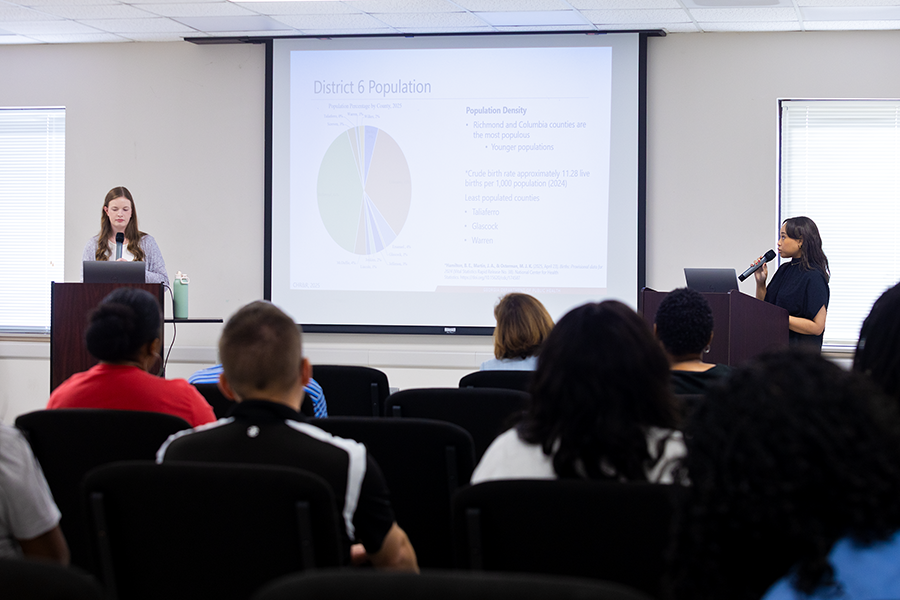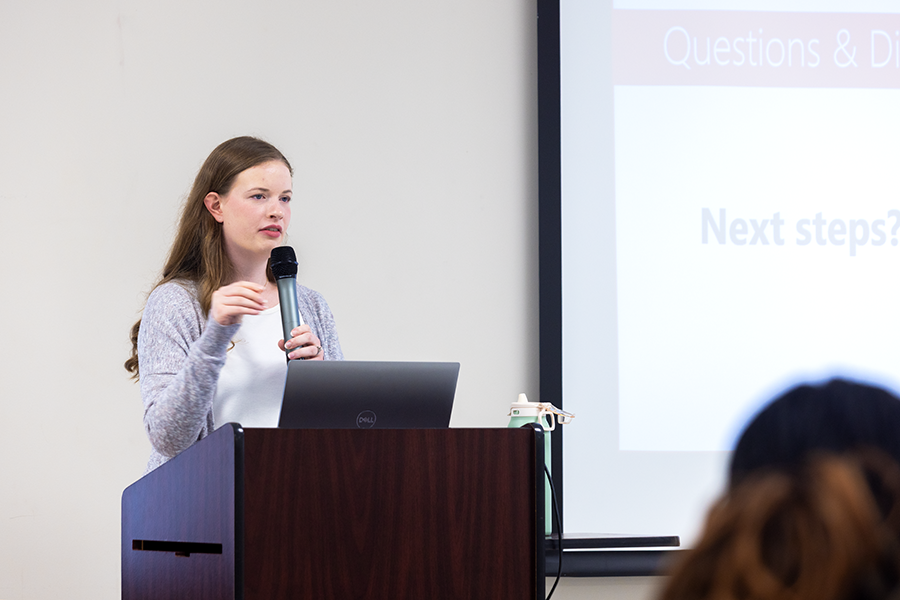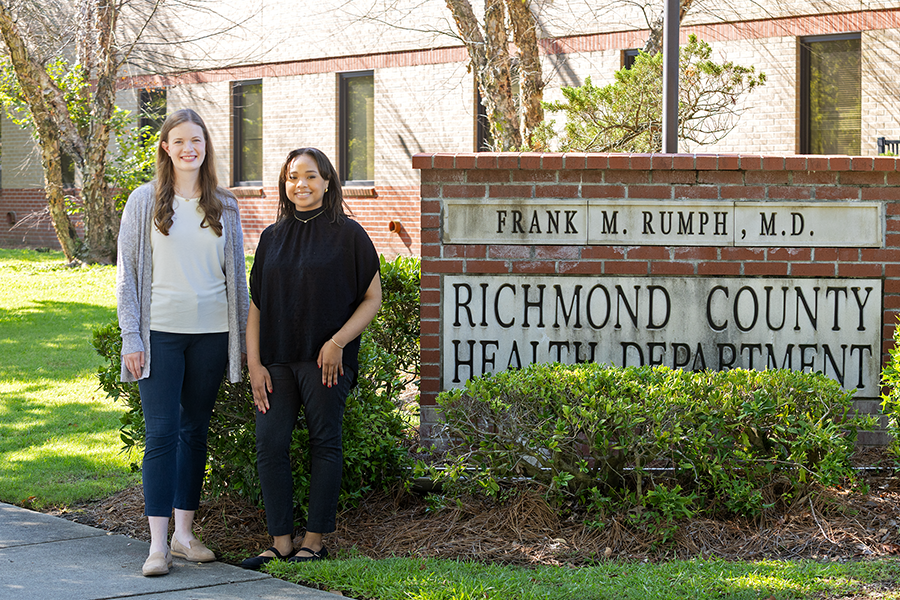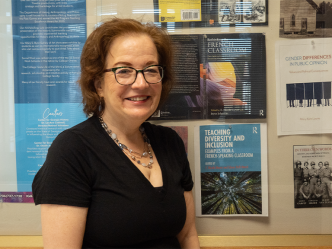A new partnership between Augusta University and the Georgia Department of Public Health East Central Health District 6 is providing students valuable experience, as well as a chance to leave their mark on the lives of Georgians living in the 13 counties in the district.
Three students from AU’s School of Public Health have participated in the new internship program with DPH’s District 6 office located in Richmond County. Primarily rural, District 6 includes Burke, Columbia, Emanuel, Glascock, Jefferson, Jenkins, Lincoln, McDuffie, Richmond, Screven, Taliaferro, Warren and Wilkes counties.
Since January 2025, AU students Josiah Barnes, Hannah Copp and Jasmine Jones have provided support to DPH, particularly as it pertains to data compilation and analysis. The new partnership, which is open to students from AU’s SPH, College of Allied Health Sciences, James M. Hull College of Business, College of Nursing, Katherine Reese Pamplin College of Arts, Humanities, and Social Sciences and others, allows students to see firsthand how the Department of Public Health works to meet the needs of Georgians, particularly those living in remote and underserved areas.
“Internships are a critical and very practical component of our MPH program, offering students the opportunity to apply their training in real-world settings, preparing them for careers in public health and helping them network within our community to find that post-graduation job,” said Teresa M. Waters, PhD, dean of AU’s School of Public Health. “These internships also build a critical bridge between AU and DPH, providing invaluable feedback on our educational programs and helping us identify additional collaborative opportunities to meet the needs of our community.”
“We learned the value of key county-level data, but it’s not always as widely available or accessible as state-level data. We also compared county-level data to both state-level and national-level data so the DPH team can examine different health trends and patterns.”
Jasmine Jones, second-year MPH student
“We’ve always loved interacting with local college students, and the work Josiah, Hannah and Jasmine did will influence where our department focuses our resources to impact public health. We’ll be taking the data they compiled out to the counties we serve in this district,” said Lee Donohue, MD, the district health director and a former faculty member of the Medical College of Georgia at Augusta University where she led the Internal Medicine Residency program after serving as the associate program director and chief of the Department of Medicine’s Division of Internal Medicine. “It’s so much more meaningful to see the data extrapolated down to your own ZIP code and neighborhood. The leaders in the communities we serve want to see what their health metrics look like and how they compare to others in our district and state.”

Christine O’Meara, a grants specialist with a Master of Public Health and the former director of Cancer Information and Awareness at the Georgia Cancer Center at Augusta University, served as the preceptor for Barnes during the spring 2025 semester and then Copp and Jones this summer.
“It’s a win-win because the students need experience in different disciplines, including data synthesis, and we are then able to use the data they have collected, analyzed and interpreted to help with grant proposals and program planning,” O’Meara said. “We have already used data from the spring, and we are excited to share these new databases moving forward. The students are building data analysis and communication skills, and we’re able to put their findings to practical use —whether that’s in grant proposals or informing our county health departments’ staff and boards.”
The data analysis included exploring broad socio-demographic indicators like age distribution, education levels and population trends, alongside health behaviors and outcomes ranging from infant mortality rates to tobacco use, obesity and food security, just to name a few. Over the course of their internships, the students utilized data from the County Health Rankings and Roadmaps 2025 database, which is managed by the University of Wisconsin through funding provided by the Robert Wood Johnson Foundation, as well as data from the Georgia Rural Health Innovation Center and the Centers for Disease Control and Prevention and other sources. It was an exercise in identifying the right places to find the data needed to give a better snapshot of what is happening in each county within the district.
“A lot of our counties are very small, and some key indicators data we wanted to assess is lacking or incomplete. That meant investigating other resources, so we learned how to navigate multiple resources available to us and put together a more comprehensive dataset to present.”
Hannah Copp, fourth-year medical student on the MD-MPH track

“Internships provide our MPH students with applied practice experiences, and such experiences gained by these students at DPH District 6 this year served both our students and the community well,” said Jie Chen, PhD, associate dean for Academic and Student Affairs. “It is a great testament of how our public health education program is well integrated with practices in the public health domain and how our students achieved these important competencies in the public health education.”
For Jones, a second-year MPH student with a concentration in health informatics who hopes to go into public health administration, it was the chance to learn more about a part of the state she has called home while gaining valuable experience for her career. Prior to obtaining her undergraduate degree at the University of Georgia, Jones grew up in Augusta and attended Davidson Fine Arts Magnet School.
“Our primary goal was to analyze each of our 13 counties’ strengths, weaknesses and opportunities to improve across different facets of public health,” Jones said. “We learned the value of key county-level data, but it’s not always as widely available or accessible as state-level data. We also compared county-level data to both state-level and national-level data so the DPH team can examine different health trends and patterns.”

During the summer term, Jones and Copp each selected six counties plus one shared county to develop visual reports comparing county-level trends to state averages. Their final slide deck offers both a district-wide overview and detailed local-level insights for selected counties.
Copp, a fourth-year medical student on the MD-MPH track, hopes to take what she has learned in her program and this internship into providing better care for children in her chosen specialty of pediatrics.
“A lot of these counties don’t have the resources to collect their own data, so the more robust County Health Rankings and Road Maps database is a really helpful resource for them to be able to access that data. But it does have its limitations,” Copp said. “A lot of our counties are very small, and some key indicators data we wanted to assess is lacking or incomplete. That meant investigating other resources, so we learned how to navigate multiple resources available to us and put together a more comprehensive dataset to present.
“The other thing we learned was how to tell a story using the data,” she continued. “That is a really powerful skill to have because it can drive public health initiatives and policy change. And the hope of the health department is to use what we’ve created in the deliverables to help with grant proposals and funding.”

Copp and Jones presented their findings on Friday, July 25. The data and reports they generated will be used by O’Meara and other DPH staff when applying for grants and looking for where to deploy resources, and it will also be made available to leaders and health boards in each county.
As funding sources become more competitive and rural communities face growing public health demands, this partnership exemplifies how academic institutions and public agencies can work together to build stronger, data-driven support systems.
“Internships are a critical and very practical component of our MPH program, offering students the opportunity to apply their training in real world settings, preparing them for careers in public health and helping them network within our community to find that post-graduation job.”
Teresa M. Waters, PhD, dean of AU’s School of Public Health.
“It’s important to get the information out, so we will be sharing the interns’ slide deck, as well their synopsis with each county,” O’Meara said. “This project had several dimensions, and we will employ the data and counties’ summaries to help drive programmatic priorities and grant applications to assist the counties.”
Moving forward, O’Meara is hoping to continue to develop and expand the scope and impact of the partnership with AU. Beyond the public health data project, another internship initiative will focus on nonprofit infrastructure development. Interns will research top industries in each county and create a resource directory of local employers with charitable giving programs. This work will help identify funding opportunities for rural health departments seeking to address community needs such as signage, facility improvements, services or public education efforts.
“This is such a great synergy for us in public health to work with universities in the area and really improve what we can offer for the community together,” Donohue said. “Having these younger voices where they can say, ‘I can make an impact with my group,’ that’ll hopefully start changing trends. I hope this experience will inspire them for whatever directions their careers go, and I hope they have great, vibrant careers.”
 Augusta University
Augusta University




